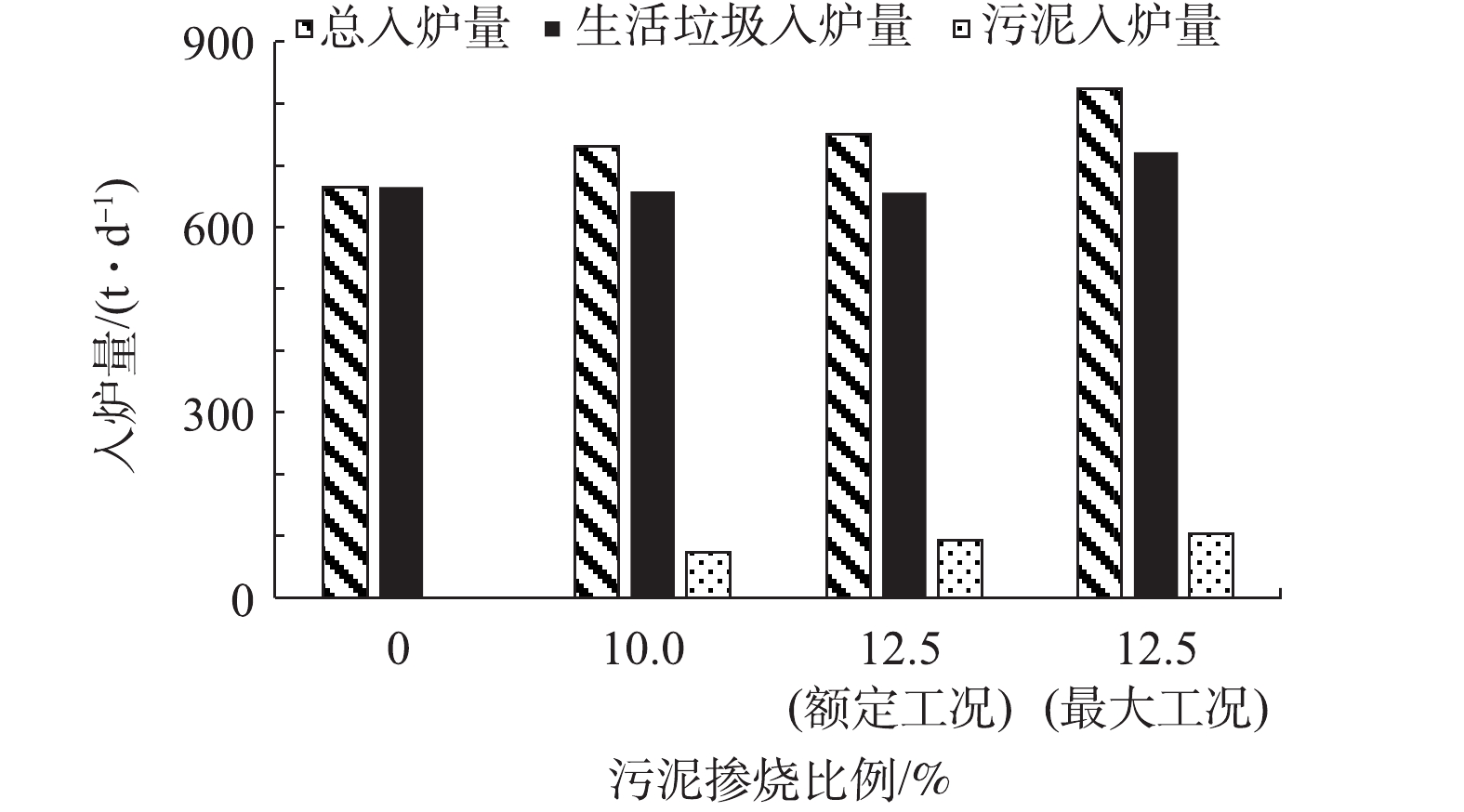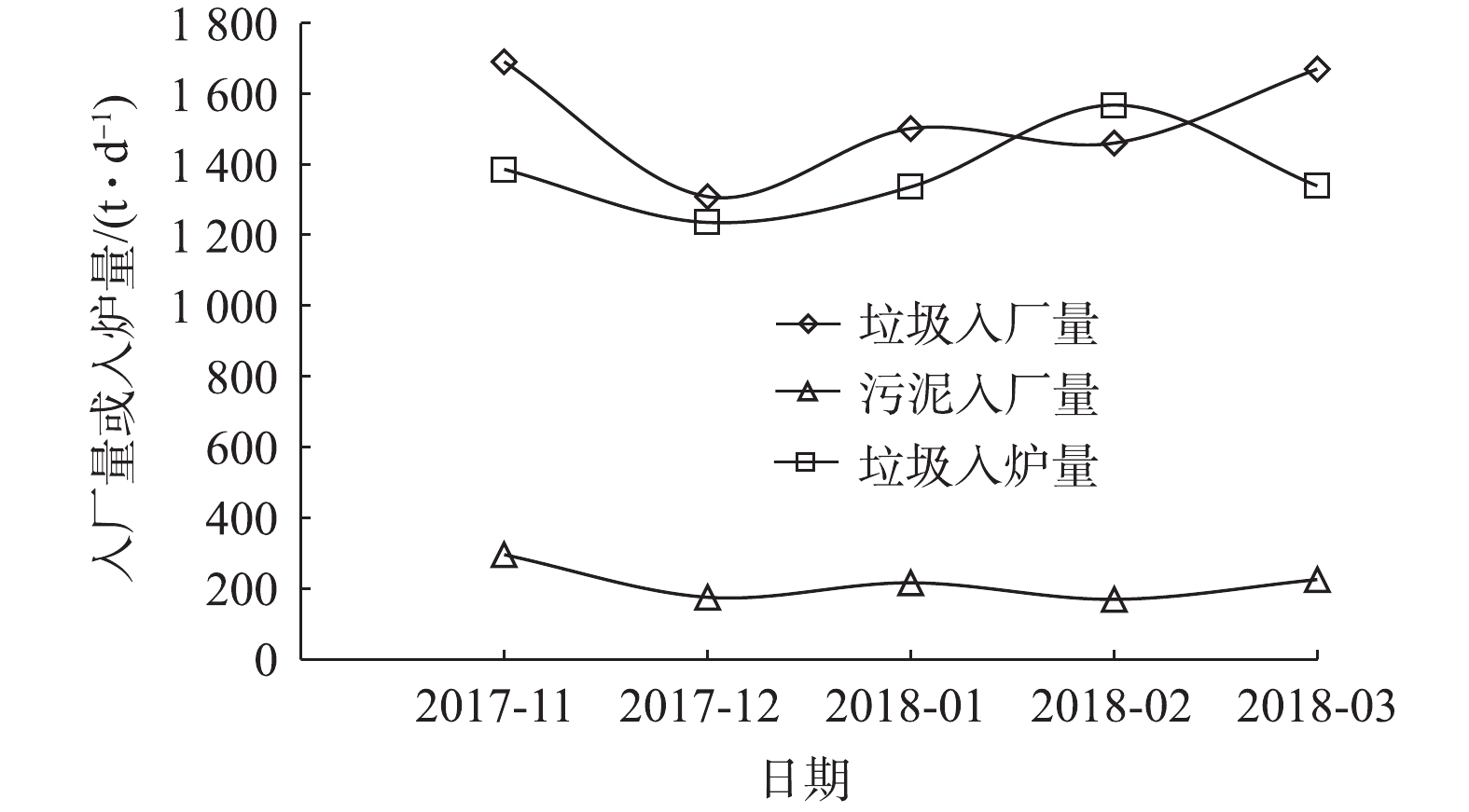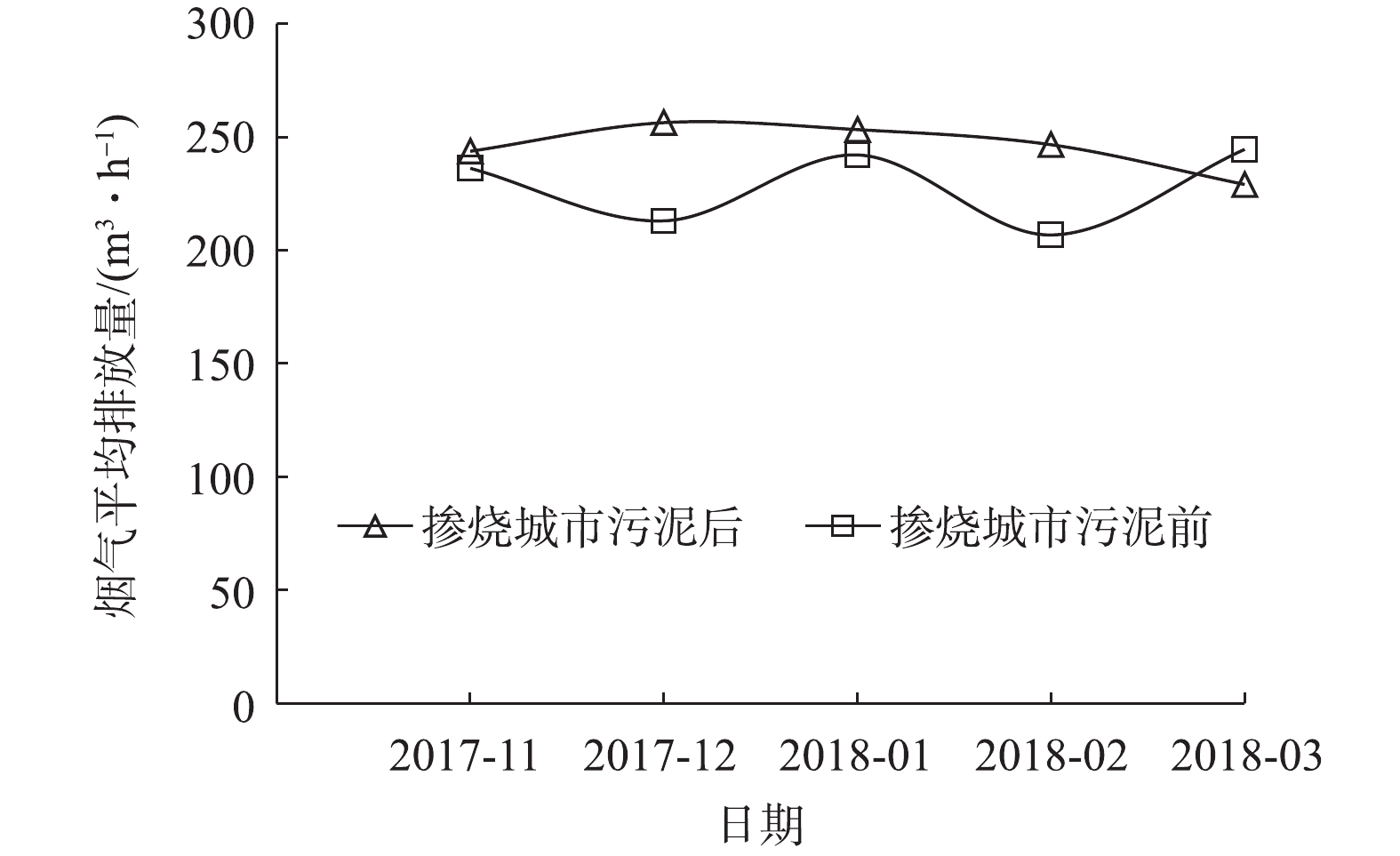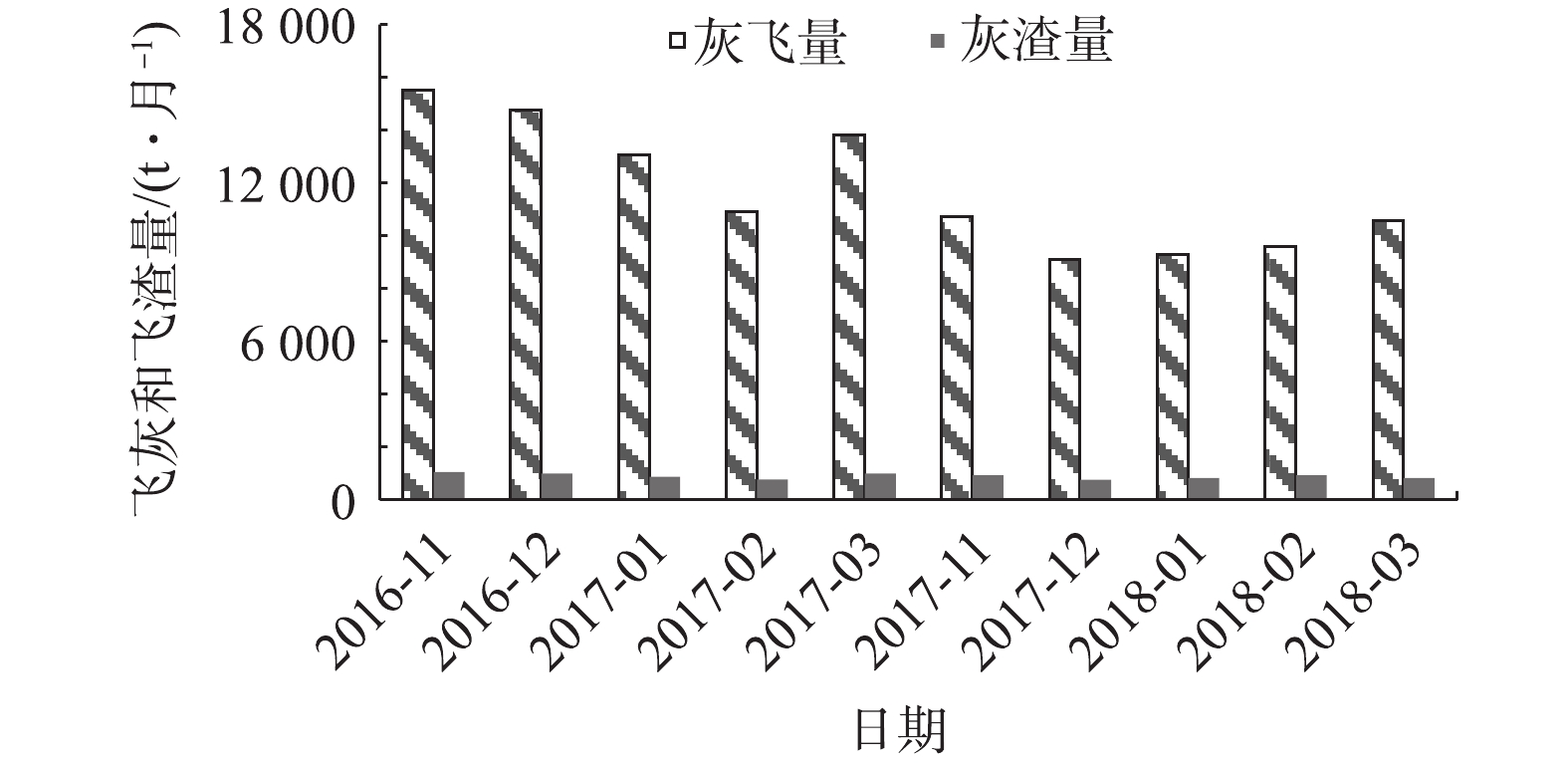-
目前,我国各大城市污泥处理处置压力巨大,多数污水处理厂的污泥未得到有效处理处置[1]。据预测,2020年我国城市污泥产生量将突破6×107 t·a−1(含水率80.0%),北京市的污泥产量也将达到2×106 t·a−1(含水率80.0%)[2]。近年来,北京市实施了污水治理三年行动计划,污水处理量大幅增加,污泥量也随之剧增。据不完全统计,每年北京市约有50.0%污泥得不到有效处置[3]。
目前,污泥处置主要方式有填埋、焚烧、建材利用,或经好氧发酵后土地利用(土壤改良、林地利用或农业利用等)。从2000年开始,欧洲已经对污泥填埋征收填埋税,要求减少直至完全禁止填埋。污泥作为建材原料在国外也有相关研究和实践,但污泥建材利用存在产品质量及环境污染风险等问题。污泥土地利用是一种有效的污泥最终处置方式。然而,污泥土地利用存在一定的潜在风险[4],若施用不当,容易造成环境的二次污染。相较于其他城市污泥处置技术,污泥焚烧在经济发达地区有其发展潜力[5],是一种成熟可靠的污泥处置方式[6]。将城市污泥直接掺烧到生活垃圾焚烧厂,关于直接掺烧比例和如何保证污染物达标排放,在国内还未见报道,更无大规模应用。而探索生活垃圾焚烧厂直接掺烧城市污泥是有意义的尝试[7]。掺烧城市污泥可以利用现有生活垃圾焚烧厂设备,有效实现两者体积和质量的减少,最终实现其无害化处理处置[8]。另外,采用掺烧城市污泥技术处置污泥可直接利用垃圾焚烧厂的设备,与生活垃圾共用焚烧设备及烟气净化等公用设施,只需增加污泥输送系统设备,大大降低了运营和维护成本[9-10]。
为研究不同比例下直接掺烧城市污泥对垃圾焚烧厂系统的影响,按照一定比例在城市生活垃圾焚烧厂直接掺烧城市污泥,将含水率80.0%左右的城市污泥直接掺烧到垃圾焚烧炉中,研究掺烧城市污泥前后对生活垃圾焚烧厂焚烧系统的影响。本研究的时间跨度将近3年,并对可能产生的二次污染问题提出有效的污染控制措施,以期为解决污泥处理处置问题提供新思路。
全文HTML
-
实验在城市生活垃圾焚烧厂现有装置中进行。在不影响焚烧厂稳定运行的情况下,结合理论计算,将城市污泥直接掺烧比例控制在20.0%以内进行现场实验。研究从2016年开始,至2018年结束,跨越3年。
焚烧炉数量为2台,焚烧炉炉排型式为SN型炉排。每台焚烧炉额定处理垃圾量为800 t·d−1(即33.33 t·h−1),进炉垃圾低位发热量为8 044 kJ·kg−1。每台余热锅炉额定蒸发量为73.8 t·h−1,省煤器出口烟温190~200 ℃,锅炉热效率保证值79.8%。焚烧炉-余热锅炉年能力工作时间为8 000 h。污泥掺烧按照10.0%和12.5%比例进行(比例有时根据工况进行调整,最大不超20.0%)。污泥含水率小于80.0%。
根据实验研究所做出的工况调整:当焚烧炉炉膛温度超过950 ℃时,且蒸发量处于稳定期时投入污泥上料系统;当炉温下降至900 ℃时,减少污泥给料量,以确保炉温在850 ℃以上,从而保持焚烧锅炉负荷稳定。
-
通过前拱的4个给料点和后拱的4个给料点,把污泥直接送入焚烧炉,并根据污泥掺烧运行工况适当调整切换给料点,保证污泥和垃圾的均匀混合。污泥通过全封闭管路及变位器泵送至焚烧炉的前拱和后拱,最终进入垃圾焚烧炉进行焚烧。
-
掺烧城市污泥来自于多个城市污水处理厂及工业企业的污水处理站。为确保掺烧的城市污泥为一般固体废物,在直接掺烧前,对所有污泥性质进行了监测,掺烧污泥含水率在72.3%~80.9%,pH为6.07~7.40,矿物油含量213~2 980 mg·kg−1,有机质含量50.0%~62.0%。
根据《关于污(废)水处理设施产生污泥危险特性鉴别有关意见的函》(环函[2010]129号)中的规定,专门处理工业废水(或同时处理少量生活污水)的设施产生的污泥,可能具有危险特性,应按《国家危险废物名录》、《危险废物鉴别技术规范》和《危险废物鉴别标准》的规定,对污泥进行危险特性鉴别。实验前,将本研究用到的城市污泥进行检测和危险废物鉴别,确保其属于一般固体废物,符合入炉要求。
-
重金属、二恶英和酸性气体等是污泥焚烧排放的主要大气污染物。对本研究中污泥焚烧排放的尾气采用紫外光谱吸收法在线监测和手动现场采样监测相结合的方法进行监测。手动现场采样监测方法按照《生活垃圾焚烧污染控制标准》(GB 18485-2014)中规定的测定方法进行。
1.1. 实验装置
1.2. 掺烧方式
1.3. 掺烧城市污泥性质
1.4. 焚烧排放污染物测试方法
-
对于干基低位热值为10 000 kJ·kg−1的城市污泥,水分达到79.9%时,混入生活垃圾的混烧污泥不提供能量,其热值将全部用于污泥含水的蒸发[11]。任庆玖[12]对城市生活垃圾与污泥进行混烧发现,含水率大于80.0%的污泥掺烧会降低热值,掺烧比例过高会引起炉温或工况的波动,严重时需辅助燃料助燃。已有研究表明,若污泥掺入的比例过大,会引起混合燃料含水率过高,导致热值降低,从而影响混合燃烧运行。因此,必须保证垃圾和污泥保持适当的混合比例。为保证垃圾焚烧炉的正常运行,一般将掺烧污泥比例控制在20.0%以内[13]。
在掺烧前通过理论计算,确定合理的掺烧比例。研究所在焚烧厂的生活垃圾低位热值为8 044 kJ·kg−1(平均值)。干污泥的热值为14 000 kJ·kg−1(理想值),污泥含水率为80.0%,水分的气化潜热以2 500 kJ·kg−1进行理论计算。若混合试样的低位热值为QL,污泥占混合试样的比例为X,计算方法[14]见式(1)和式(2)。
根据热值和可焚烧性的关系,计算出在5种条件下临界值时试样的混合比例,结果见表1。
若要保证稳定地焚烧供热发电,低位热值需大于6 000 kJ·kg−1[14]。根据计算结果和运行经验,当掺烧城市污泥比例小于20.0%时,混合试样的热值大于6 000 kJ·kg−1,可进行焚烧发电。当污泥按照10.0%~20.0%掺烧比例与生活垃圾进行混合焚烧时,混合试样的着火温度相差不大。当掺烧比例超过30.0%,混合试样的着火温度上升,其综合燃烧的性能将变差。因此,本研究将污泥掺烧量控制在20.0%以下,这与陈兆林等[15]的研究结果相一致。
-
随着垃圾分类措施开始施行,未来垃圾焚烧厂入厂垃圾热值会进一步升高,焚烧炉处理量将呈现下降趋势。若要提高垃圾处理效率,必须通过降低入炉热值以保证焚烧炉的入炉量。因为城市污泥具有含水率高、热值低的特点,所以可通过掺烧城市污泥来降低入炉垃圾热值,从而提高入炉焚烧量。不同掺烧比例下,每日总入炉量和生活垃圾入炉量的变化情况见图1。由图1可知,污泥掺烧比例为12.5%时,额定工况下的每日最大入炉量为749.51 t·d−1(其中,生活垃圾每日入炉量为655.85 t·d−1,污泥每日入炉量为93.69 t·d−1),比不掺烧污泥时每日可增加84.37 t的入炉量,生活垃圾的每日入炉量略有降低,但影响程度不大。当在110.0%最大额定工况运行时,每日最大入炉量为824.46 t·d−1(其中,生活垃圾每日入炉量为721.40 t·d−1),比不掺烧污泥时每日的垃圾入炉量增加56.26 t·d−1。因此,城市污泥按12.5%的比例掺烧时,对生活垃圾入炉量的影响不大。
为研究掺烧城市污泥(含水率80.0%)对垃圾入炉量的影响,对相关运行数据进行了记录监测。掺烧污泥前(2016年11月—2017年3月)垃圾入厂量和入炉量的情况见图2;掺烧城市污泥后(2017年11月—2018年3月)垃圾入厂量和入炉量的情况见图3。
未掺烧污泥前,2016年11月—2017年3月垃圾入厂量和入炉量都呈下降趋势,垃圾每日平均入炉量仅为1 380.85 t·d−1,为设计值的86.3%。掺烧污泥后,2017年11月—2018年3月垃圾入厂量和入炉量均呈上升趋势,每日垃圾平均入炉量为1 373.49 t·d−1,每日污泥和垃圾的入炉总量平均为1 590.31 t·d−1,为设计值的99.4%。
分析以上数据可知,掺烧平均比例为12.5%~13.64%的城市污泥(含水率80.0%)时,生活垃圾的日入炉量并不会产生较大影响,但日入炉总量有较大提升,可达到额定处理量的99.4%,这也极大提高了焚烧炉的机械负荷。
-
焚烧炉采用烟气脱酸除尘一体化系统+活性炭石灰喷射+炉内脱硝等技术对烟气进行处理,处理后的烟气进入袋式除尘器。烟气颗粒物、中和反应物和活性炭吸附物均在除尘器中被捕集。除尘后烟气经引风机进入80 m高的集束烟囱排入大气。烟气脱酸除尘一体化系统以Ca(OH)2作为酸性气体的吸收剂,石灰和活性炭混合物用喷射风送入反应段入口。烟气中的酸性成分被混合物中的碱性成分Ca(OH)2吸收,生成CaSO3、CaSO4和CaCl2等。活性炭作为吸附剂可吸附重金属、二恶英和呋喃等。布袋除尘器采用两通道布置,除尘效率大于99.7%。采用正压浓相气力输送系统连续排灰,洁净的烟气通过引风机排入烟囱。炉内脱硝采用选择性非催化还原法(selective non-catalytic reduction,SNCR),烟气中的NOx被还原成N2、O2及水蒸气,处理后的烟气高空排放。
烟气量增加除对燃烧工况有一定影响外,还可能对排放的污染物有影响[16]。2016年11月—2017年3月(未掺烧城市污泥前)和2017年11月—2018年3月(掺烧城市污泥后)两段时期,烟气排放量变化情况见图4。
由图4可知,掺烧城市污泥后垃圾焚烧炉烟气的小时平均排放量比同时段的烟气排放量略有增加。根据统计计算,掺烧城市污泥后烟气的月平均排放量比掺烧污泥前增加了8 621 m3·月−1。这是由于污泥含水率较大(80%左右),转化的蒸汽量也大,导致烟气量略有增加。从整体上看,掺烧城市污泥对整个垃圾焚烧系统的烟气排放并未产生较大影响。
此外,比较掺烧城市污泥前后废气排口的大气污染物的监测数据(见表2)可知,烟气污染物排放浓度能满足《生活垃圾焚烧污染控制标准》(GB 18485-2014)的相关标准要求。
垃圾焚烧厂对二恶英进行了监测,监测结果表明垃圾焚烧厂在未直接掺烧城市污泥前后排放的二恶英类均满足《生活垃圾焚烧污染控制标准》(GB 18485-2014)相关限值(≤0.1 ng·m−3)要求(见表3)。
垃圾焚烧厂在生活垃圾掺烧城市污泥后,其排放的污水基本没有变化。在垃圾焚烧厂掺烧城市污泥前(2016年11月—2017年3月)和掺烧城市污泥后(2017年11月—2018年3月)飞灰和灰渣产生量对比情况见图5。在掺烧城市污泥后,垃圾焚烧厂飞灰和灰渣产生量相比较同时段的飞灰和灰渣产生量有减少,掺烧城市污泥对整个垃圾焚烧炉飞灰和灰渣产生量的影响可以忽略。
根据监测结果,焚烧飞灰样品各项指标均能达到《生活垃圾填埋场污染控制标准》(GB 16889-2008)。炉渣经过鉴别后属于一般固体废物,交由垃圾填埋场填埋处置。
-
根据前文数据,掺烧污泥比例逐渐增加时,燃烧工况会出现波动,同时烟气量也会有所增加。特别是在比例超过20.0%时,烟气经过2 s的流动,温度低于850 ℃,无法满足完全燃烧的要求,个别污染物排放浓度上升。为有效减少直接掺烧污泥对整个系统的影响,在掺烧过程中对工况和污染控制采取微调措施。
生活垃圾焚烧厂除了采用原有的烟气脱酸和除尘一体化系统、活性炭石灰喷射、炉内脱硝等措施控制烟气中污染物的排放外,还可采取了以下措施:1)严格控制掺烧比例不超过20.0%。在锅炉炉膛温度超过950 ℃,且蒸发量处于稳定期,投入污泥上料系统。根据炉膛温度变化情况,调整入炉污泥掺烧量。同时保证垃圾焚烧炉在正常运行时炉膛内烟气温度大于850 ℃,滞留2 s以上,并使烟气有足够的扰动;2)为有效控制掺烧后CO和二恶英排放浓度的升高,在掺烧过程中提高过量空气系数,以增加炉膛内氧浓度,实现垃圾完全燃烧,从而有效抑制二恶英类的生成。将烟气含氧量控制在6.0%~9.0%,即过量空气系数在1.40~1.75,烟气中CO浓度低于100 mg·m−3(标准状态下);3)在掺烧过程中,布袋压差因污泥掺烧量的增加出现递增,同时SO2、CO、HCl及重金属的排放略有上升。根据实际工况,在运行中及时调整布袋反吹压力,降低布袋压差,提高布袋的通流性,并根据SO2和HCl的排放情况,调整石灰给料量及再循环返料量。另外,为降低掺烧污泥带来重金属排放增加的风险,在原来的基础上增加污泥中活性炭投放量为0.05 kg·t−1,确保烟气中的重金属达标排放。
掺烧城市污泥过程产生的固体废物主要有焚烧炉炉渣和飞灰等。掺烧城市污泥后,灰渣量相对掺烧污泥前变化不大。为了防止飞灰飞扬对环境的影响,在料仓上设有抽风罩和布袋除尘器,房间内所有的抽风管也都装过滤器或过滤网,各滤网(袋)上积灰定期清除,交给有资质的单位进行处理处置。
2.1. 城市污泥与生活垃圾掺烧比例的确定
2.2. 掺烧城市污泥对生活垃圾入炉量的影响分析
2.3. 污泥掺烧对污染控制系统的影响
2.4. 污染控制措施
-
1)城市污泥直接掺烧必须符合国家相关规定,直接掺烧的污泥含水率应该小于80.0%,比例不大于20.0%,且必须是一般固体废物才能进入垃圾焚烧厂进行直接掺烧。
2)根据掺烧结果可知,直接掺烧12.5%左右的污泥混烧,对生活垃圾入炉量及焚烧炉稳定以及污染物的排放量均未产生较大影响。根据掺烧城市污泥的烟气监测结果,直接掺烧城市污泥后,排放的污染物浓度略有升高,但都满足排放相关限值要求。掺烧前后产生的固体废物产生量没有太大变化,未对周围环境造成影响。
3)为有效控制废气中各污染物的排放浓度,应严格控制直接掺烧城市污泥的含水率和掺烧比例,根据炉膛温度变化情况(炉膛温度超过950 ℃),调整入炉污泥掺烧量。在掺烧过程中提高过量空气系数,增加炉膛内氧浓度,抑制二恶英类污染物生成。根据运行情况进行及时调整,适当增加石灰和活性炭的给料量,确保污染物稳定达标排放。
4)生活垃圾焚烧厂按照一定比例直接掺烧城市污泥(含水率80.0%)在技术上可行,污染物排放可控。该技术未来可作为一种解决污泥出路的有效处置方法。




 下载:
下载:






